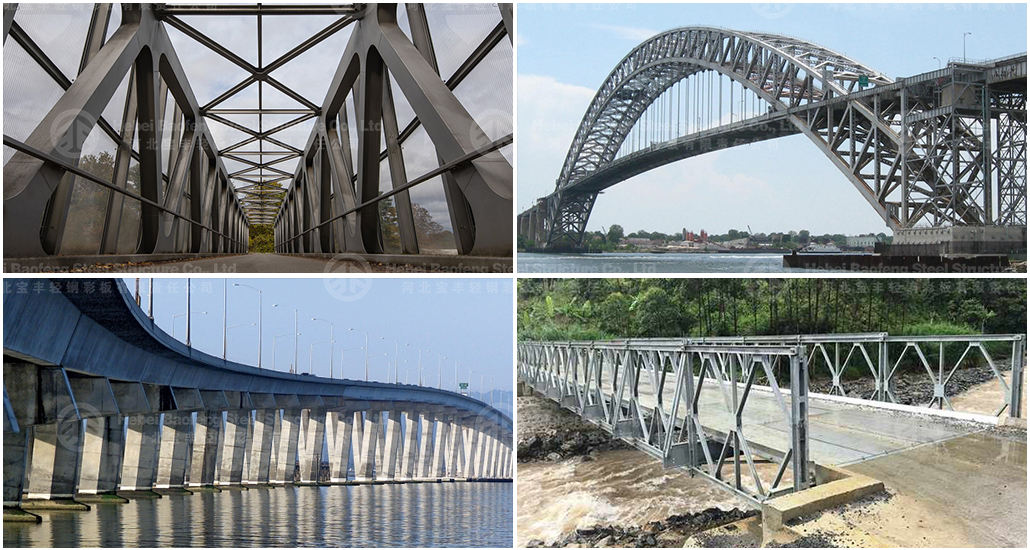
Types of Steel Bridges
Steel bridges are diverse structures categorized by their design, load-bearing mechanisms, and materials. Here's an organized overview of the main types, highlighting their characteristics and applications:
1. Suspension Bridges
Structure: Uses cables anchored to towers or abutments to support the deck. Steel is prominent in cables, towers, and anchorages.
Features: Ideal for long spans (over 500 meters), with flexibility to withstand dynamic loads.
Examples: Golden Gate Bridge (USA), Akashi Kaikyō Bridge (Japan).
Advantages: Efficient for very long spans, aesthetic appeal.
2. Beam Bridges
Subtypes:
Box Girder: Hollow steel sections for torsional strength; used in highways and railways.
Example: Millau Viaduct’s approach bridges (France).
Plate Girder: I-beams or rectangular plates for shorter spans (up to 100 meters).
Example: Urban highway overpasses.
Simple Beam: Horizontal steel beams supported by piers.
Features: Straight, rigid decks; cost-effective for mid-length spans.
3. Truss Bridges
Structure: Triangular frameworks (Pratt, Warren, Howe, Baltimore trusses) to distribute loads efficiently.
Features: Lightweight, strong, and suitable for railroads and roads.
Examples: Brooklyn Bridge (USA, hybrid suspension-truss), Iron Bridge (UK).
4. Cantilever Bridges
Structure: Deck extends horizontally from supports on both ends, balanced by counterweights.
Features: Reduces material use for long spans; common in railroads.
Examples: Forth Bridge (Scotland), Quebec Bridge (Canada).
5. Arch Bridges
Subtypes:
Tied-Arch: Deck is tied to the arch below for stability (e.g., Sydney Harbour Bridge, Australia).
Fixed-Arch: Traditional arch with vertical supports.
Features: Aesthetic and efficient for medium spans; steel allows larger arches.
6. Cable-Stayed Bridges
Structure: Cables run directly from towers to the deck, reducing cable numbers compared to suspension bridges.
Features: Moderate to long spans (200–800 meters); modern and sleek appearance.
Examples: Millau Viaduct (France), Oriental Pearl Tower Bridge (China).
7. Movable Bridges
Subtypes:
Drawbridges: Raised vertically via counterweights.
Bascule Bridges: Rotated horizontally on a pivot (e.g., Tower Bridge, London).
Swing Bridges: Rotated 90° for ship passage.
Features: Steel mechanisms for reliable operation; essential in busy waterways.
8. Floating Bridges
Structure: Steel pontoons or floats support the deck on water.
Features: Temporary or permanent solutions for soft soil or water crossings.
Examples: pontoon bridges in military or emergency use.
9. Hybrid Bridges
Subtypes:
Steel-Concrete: Steel frames with concrete decks (common in highways).
Steel-Wood: Light steel trusses with timber decking (pedestrian use).
Features: Combines materials for cost, weight, and sustainability benefits.
10. Pedestrian Bridges
Structure: Lightweight steel trusses, cable nets, or walkways.
Features: Narrow, durable, and often aesthetically designed.
Examples: Manhattan’s High Line (USA), London’s Garden Bridge (UK).
Key Advantages of Steel:
Strength-to-Weight Ratio: Ideal for spanning large distances.
Durability: Resists corrosion with modern coatings.
Flexibility: Adapts to dynamic loads (e.g., earthquakes, wind).
Sustainability: Recyclable and energy-efficient in production.
Each type suits specific environments and requirements, leveraging steel’s versatility to meet engineering challenges.

فئات
أحدث مدونة